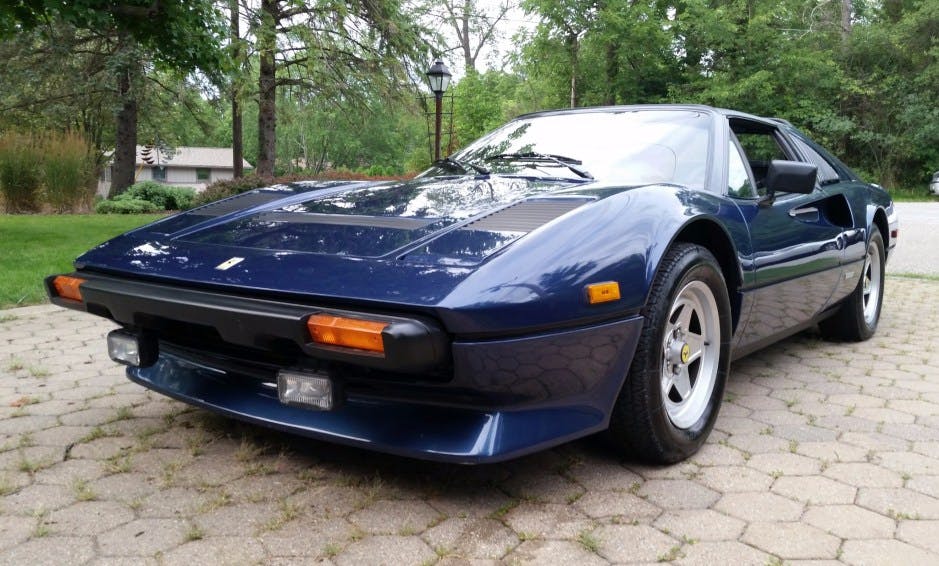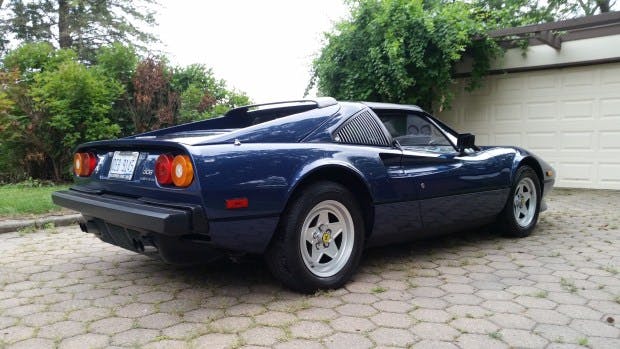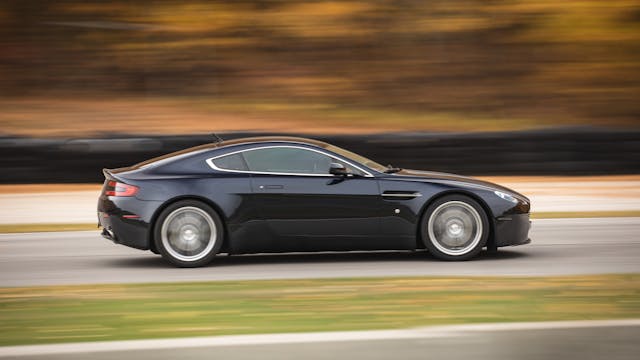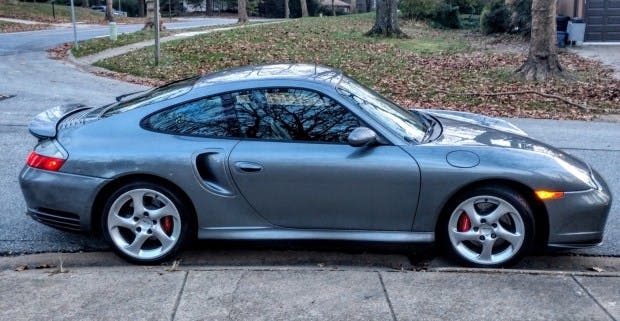A Ferrari 308 Taught Me Why Analog Exotics Are Great—And Expensive
Almost 10 years ago to the day, I bought a Ferrari, a 1984 308 GTS Quattrovalvole. For the record, it was blue, not red. It was the second to last in a series of exotic, and semi-exotic cars that I’ve owned on a fairly constricted budget. And, after much thought, I can’t help but conclude it will probably be the last car like it that I buy. Not because it wasn’t a joy to have, but because the market for old-school, DIY-friendly, analog exotics has shot through the roof since that 308 came into my life. Sure, there may be attainable things out there that might be cheap to buy, but that’s where the “cheap” part ends. Are there any choices left?


When I bought it, the 308 occupied a sweet spot that doesn’t seem to exist anymore. I paid 42 grand, a significant amount of money but temptingly good value for something with a Ferrari badge, Pininfarina lines, and a four-cam V-8. In four years of Ferrari ownership, I spent less than $5000 in maintenance, and I drove the car almost 2000 miles a year. Not exactly Kia-level costs, but surprisingly not awful for something with a prancing horse on the nose. It was also a joyfully simple car, and many jobs were a genuine DIY proposition. Hell, Hagerty’s Editor in Chief Larry Webster is restoring the 2+2 version of my car largely by himself, even if all isn’t going according to plan.
Truth be told, I’d love another Ferrari. But even a Mondial, which despite being a Ferrari made plenty of “worst cars” lists, will generally sell for close to what I paid for my much more desirable 308 a decade ago. Replacing that 308 would be a six-figure proposition today. Not in the cards with two kids rapidly approaching college age.

So, if Ferrari ownership is out but exotics are still on the brain, what about something British? If I’ve owned Magnum P.I.’s whip, why not 007’s? A DB7, DB9 or a V8 Vantage with a manual transmission has always been on my radar. After the Ferrari, I very nearly bought a manual DB7 coupe. I hesitated and finally passed on the car, but a good friend of mine didn’t. He bought a blue DB7, and the cost of ownership in one year was three times what I spent on the Ferrari in four. It wasn’t just the bonkers parts prices. Unlike the Ferrari which had a number of acceptable but budget-friendly work arounds (like the $20 power window switches from the Fiat catalog), you would struggle to find Ford and Jaguar bits that worked for the Aston.
Also, the complexity of a car that was several decades newer meant that there were fewer and fewer things that owners could accomplish themselves. Just changing plugs and coils involved removing most of the intake manifold. Putting it all back together even in a slightly inexpert fashion invited an eyeful of check engine lights. As for that manual V8 Vantage I covet, it comes with the promise of a $7500 clutch job every 35,000 miles or so. By contrast, my Ferrari’s clutch was doable in an afternoon and cost about $900 in parts. There’s a reason why used Astons remain cheap, and 308 prices have increased significantly.


A Porsche 911 Turbo is a car that has always been on my short list, but I never got around to buying one when they were cheap, not an air-cooled one at least. By 2018, the ship had sailed on inexpensive air-cooled 930s. Granted, these aren’t exactly cheap cars to own, either, but they’re really simple enough. Unless you kill an engine or a gearbox, the day-to-day requirements aren’t stupefying. That’s all moot, though, because by the time I went shopping for one the price to buy a 930 was sky-high. Instead, I bought a 2001 996-generation car, which is of course a more complex automobile than the older 930. The 996 cars are now getting quite old, with lots of little plastic bits that have gone through a quarter century of heat cycles. The stubborn check engine light on mine, for example, was thanks to a plastic secondary air-injection pump failing. At just over $200, the pump itself was a rare bargain. Sadly, installing it involved lowering the engine, i.e., partially removing it. Not fun. Doing plugs and coils was similarly nightmarish and I’d rather not do it again.

With another Ferrari or 911 Turbo out of the running, maybe I’ll go back to the Brits with a Lotus Elise. Elises are a throwback in many ways. They’re uncomplicated, hyper-analog cars that are deceptively easy to live with (assuming you can handle the egress and ingress). Other than camshaft issues on certain years, their Toyota running gear is pretty stout. The only problem is the fact that the window on affordability seems has gotten much narrower. In the last five years, Elise prices have appreciated by nearly 50%. Most of the reasonably-priced cars seem to have salvage titles, the result of minor damage to the super-vulnerable front and rear fiberglass clamshells.
Indeed, the pickings are slim for the usable, attainable exotic, and I’m starting to understand why. Part of the reason why prices for analog exotics have soared so much of late isn’t just nostalgia, or style, or the joy of rowing your own gears vs. pulling on a paddle. A big part of it is what I’ve just outlined above—mere mortals can afford the maintenance costs and even do some jobs at home. By and large, that seems to be who is still buying them today, but with much higher demand for a class of car nobody makes anymore, they seem limited to mere mortals that are slightly more well-heeled than I.
***
Check out the Hagerty Media homepage so you don’t miss a single story, or better yet, bookmark it. To get our best stories delivered right to your inbox, subscribe to our newsletters.



I have noticed that many of the sports cars drawing interest are the early Computer cars. They will have Fuel injection but generally not everything is computer operated.
This is like the C5 corvette vs C7. Just so much more electronics that make it difficult to repair snd expensive.
The air cooled 911 cars of the 80’s are drawing a ton of interest because they are simple.
As for the 308. The sweet spot is the first Fuel Injection model.
You really want a bit of advancement for fuel and spark but when it moves yo door handles and many other things that fail that could easily be mechanical. It can be a night mare.
Yup. This is the appeal of the “Radwood” era cars. Enough electronics to improve the drivability, not electronics that disable the car for trivial reasons.
I have been spoiled by the corvettes, cadillacs and mustangs, they drive and handle amazingly well, durable, reliable and maintenance and repair costs negligible. i also love bmw’s, masseratis and Aston martins am willing to close my eyes to their maintenance and repair bills. The cost of owning a Ferrari, bentley, audi, porsche etc. requires a real love of the product , especially suffering with the ferrari bang/bang auto gear box. you need to take a drive in a corvette C7, Z06 stick , or a caddilac blackwing stick and you will have a rude awakening.
Stop playing badge snob and just get a Corvette….
Believe me, there’s probably a base C7 manual in my future!
This article resonates well with me. I love 80s-90s vintage analog cars. Have generally gravitated towards BMWs having had the e39 M5 and now daily an e36 M3. Also currently have a 90 Jeep Comanche with the fuel injected 4.0L, extremely reliable and still works perfect as a daily driver truck while being fun to drive. I recently purchased something newer, an 09 Honda Civic Si, im already regretting it as it is challenging to work on and an electrical gremlin nightmare.
Lotus Elises are on my list of interest too, being an avid weekend autocrossser, however their values have exploded making just one Elise more expensive than my 5 other cars combined.
I”ve been watching V8 Vantage Astons because I always wanted one. Thanks for the heads up on the clutch costs! Now I have to forget ever getting one.
the v8 from the mid 2000’s i believe was developed by Ford, very sweet engine, i have a 2006 vantage v8 stick after all these years my biggest cost is the oil filter kits and battery replacements, great car. the clutch works perfectly, but i drive the car with respect, no wheelies, burnouts etc.
Same here. I have a 2007 Vantage with over 60,000 miles on the original clutch. Any faults the original single-plate clutch had have been rectified over the years. You may replace it once, but not every 35,000 miles.
Analog cars come in many other forms that could be just as much fun. Older British sports cars (thinking late ‘60’s Triumphs) are beautiful to behold and dead-simple.
Completely agree! Many repair parts from the hardware store for my Sprite. Problems are common but clearly defined and cheap to resolve. The obsession with complicated expensive, and world class fast is way over rated, and on a drizzly day in the Northwest the crowd walks past the expensive exotics to see my Bugeye!
For those of us with modest mechanical skills and (somewhat) limited budgets, a lot of fun can be had with some kit cars, (e.g., Ultima Evolution and RS, Superlite SL-C, and various Cobra replica producers). They are usually powered by American V8s and are relatively simple without the myriad sensors of modern vehicles, but still offer excellent performance. Nicely finished machines can cost 50 to 100 thousand dollars.
I bought an E46 M for the analoge-ness and have been reasonbly rewarded with the cost/fun equation. But honestly – the 2000 miata SE is still my favorite car. Simplicity, slow car fast enjoyment and most parts are DIY fixable and at Autozone.
I too miss my 308GTB, mine was the early carb version. I also miss both of my E Types and my early 911. Sports car of the moment is a 1981 Aurora GRX. What’s that? It’s a factory built 289 Cobra that we’re actually sold new in select Ford dealerships. My driving buddies keep telling me to get a more modern sports car, 360,550, or 911. Every time I’m tempted I just can’t pull the trigger. I too have two in college now, so perhaps in a few years I’ll revisit but I’ll probably get another “old” car. Anyone have any experience with Avanti’s or perhaps Daimler SP250’s…
Seems to depend on your definition of “exotic”. E36 and E46 BMWs are terrific cars- the last great analog BMWs. But I agree, most modern cars, exotic or not, should come with a sticker on them that says “no user serviceable components inside” The pickings seem to be getting thinner and thinner.
Not an exotic but a supercar in its day, I’d suggest a C4 ZR-1. Easy enough to work on, great handling and the right sounds from its unique DOHC V8. Yeah, there’s plastic and the later cars command a justifiable premium due to NVH and hp improvements but good times to be had at price points from the high teens to about $40k depending on year, originality and miles. Cars with engine mods can be particularly rewarding to drive.
Love my 1961 Chevy engined Jag MK2 for all those kinds of reasons: more likely to start and run then not, looks great, interior is like the inside of some fancy old club, great parts availability, mostly understandable engineering…although the bimetallic strip driven gauges fall into the admired but not to be emulated category.
This is part of the appeal for the 90’s era Japanese cars. Just enough tech in them to benefit the driving experience but not too much to intrude or take away driving feel. It’s why I don’t want to part with my ’97 Supra Turbo yet despite much faster cars in existence today.
Hagerty auction passed a no reserve, high mileage, well maintained 308 last week for $60,000. I believe someone got a good deal. I have and love my 85 Quattro. Most cars depreciate (e.g., those wonderfully-awesome Corvettes) while it is expected 308s will appreciate. Rob Sass, I encourage you to keep your eyes open for a good 308 deal, they are out there. You know what your soul craves.
996 Turbos are very easy to work on, I’ve had mine for 6-7 years. #1 It’s been rock solid reliable, no check engine lights or broken parts on mine, ever and I track it. #2, you can replace that secondary air pump without lowering the motor, but lowering the motor is easy and takes less than ten minutes and two nuts. #3 Spark plugs aren’t BMW E36 M3 easy, but still aren’t hard and are done in under 2 hours.
I have owned a range of fun street cars in the past ranging from a 1964 Ferrari Lusso to an original Mini Cooper , and one of the best, bang for the buck is a Porsche 914 years 71 through 74. Very affordable, mid engine with lots of luggage space between the fronk and the trunk and great fun to drive. If the FI becomes a problem just bolt on carbs.